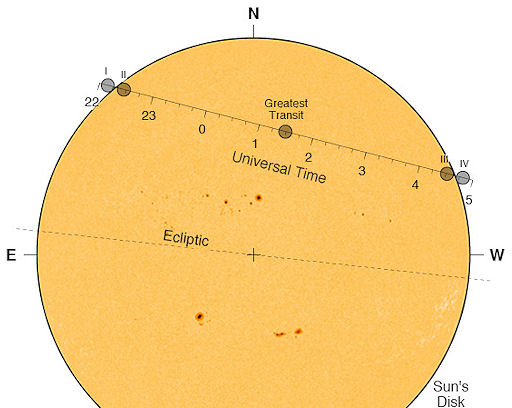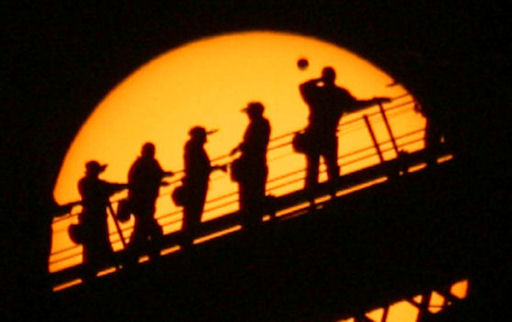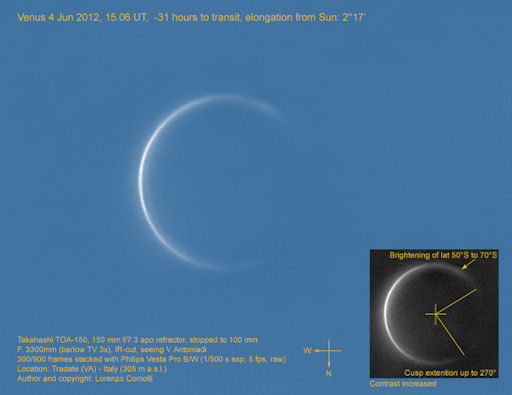SPACE DAILY Nyhetsbrev man kan prenumerera (gratis) på:
TRANSIT OF VENUS: No one reading this will still be alive the next time Venus crosses the sun in Dec. 2117. That makes today special. On June 5th at 3:09 pm PDT, the second planet begins its historic 7-hour transit of the solar disk. Observers on parts of all seven continents (map) will witness something like this:
The timing favors observers in the mid-Pacific where the sun is high overhead during the crossing. In the USA, the transit will be at its best around sunset. Creative photographers will have a field day imaging the swollen red sun "punctured" by the circular disk of Venus.
Stay tuned to Spaceweather.com's realtime gallery for constantly updated images of the transit. Another photo-stream of interest comes from the International Space Station where Don Pettit will be the first man in history to photograph a Venus transit from space. There are also many live webcasts of the transit from locations around the world: #1, #2, #3, #4. (Submit more webcast links here.)Spaceweather reader Eric Allen of Trois-Rivieres, Quebec, has combined an image of today's sun with NASA's predicted transit path:

"I created this transit 'finder chart' to know where to look for first contact," explains Allen. "That is where the Mysterious Arc of Venus might appear."
Realtime Transit of Venus Photo Gallery
[Submit your photos] [NASA videos: 2012 Transit of Venus, ISS Transit of Venus]
[Submit your photos] [NASA videos: 2012 Transit of Venus, ISS Transit of Venus]
Observing Tip: Do not stare at the sun. Venus covers too little of the solar disk to block the blinding glare. Instead, use some type of projection technique or a solar filter. A #14 welder's glass is a good choice. Many astronomy clubs will have solar telescopes set up to observe the event; contact your local club for details.
Transit of Venus Web Links:
- NASA's Transit of Venus home page
- The Mysterious Arc of Venus -- Science@NASA
- James Cook and the Transit of Venus -- Science@NASA
- Don Pettit and the Transit of Venus -- Science@NASA
- Live images from the ISS --whoa!
BEFORE THE TRANSIT: As Venus approaches the sun, it turns its nightside toward Earth. This turning transforms Venus into a rarely-seen thin ring of light. Lorenzo Comolli photographed the phenomenon from Tradate, Italy, on June 4th:
The effect is caused by particles in upper layers of Venus's atmosphere which scatter sunlight around the circumference of the planet. The ring is very difficult to observe, and often only black-belt astrophotographers are able to record the phenomenon.
"This picture was taken while Venus was a scant 2°17' from the sun's center, and it was very difficult to obtain due to the extreme proximity of the solar limb," says Comolli. "Extreme care was due to avoid the sun light entering the telescope. The extension of the crescent to form a nearly complete ring was remarkable on June 4, while nearly invisible on June 2. Another interesting observation is the limb brightening in Venus's southern hemisphere between 50° to 70° latitude. For confirmation, I obtained a second image using a W25 filter (red) that shows the presence of the brightening in the same way."

